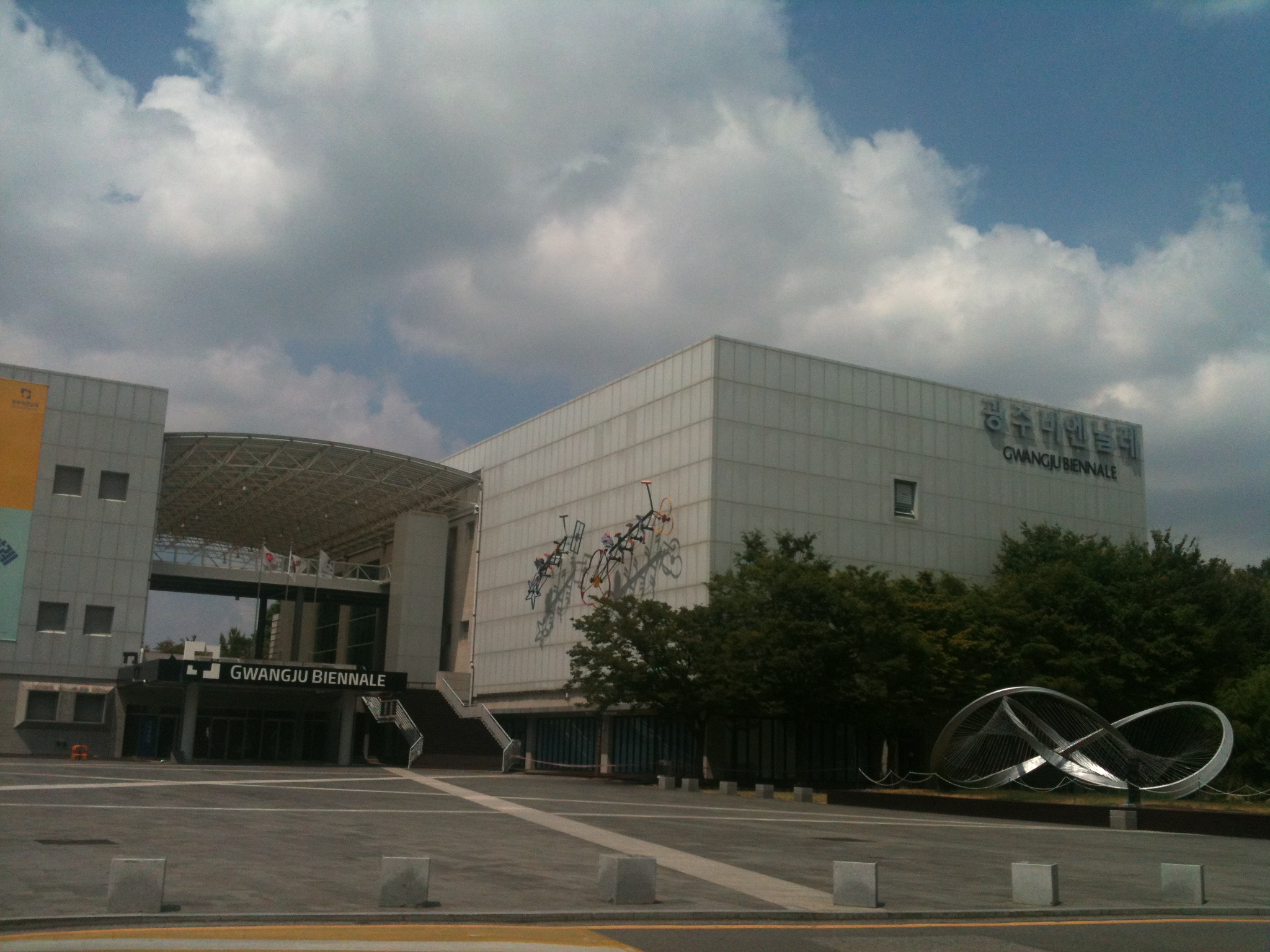|
Park Hyun-ki
Park Hyun-ki (Korean: 박현기, 1942 – January 13, 2000) is best known as a pioneer of Korean video art. Although Park lacked technological training in video and initially felt dismayed that he could not create sophisticated effects, Park purposefully chose to make his work low tech; his video artworks often display still images or document performed actions, all the while eschewing complex editing. For Park, video was just one technological instance in the histories of innovation and of exploration of the relationship between reality and illusion. In particular, Park approached the medium of video art through an Eastern worldview, and he saw video as embodying the spiritual aspects of both advanced technology and materialism.Across many of his works, Park perturbed the boundaries between the real and the virtual, to the extent that he revealed how virtual images were informed by the real, and how the virtual and the real could become interconnected spaces within the context o ... [...More Info...] [...Related Items...] OR: [Wikipedia] [Google] [Baidu] |
Art In America
''Art in America'' is an illustrated monthly, international magazine concentrating on the contemporary art world in the United States, including profiles of artists and genres, updates about art movements, show reviews and event schedules. It is designed for collectors, artists, art dealers, art professionals and other readers interested in the art world. It has an active website, ArtinAmericaMagazine.com. ''Art in America'' is influential in the way it promotes exploration of important art movements. Over the years it has continued to reach a broad audience of individuals with interest pertaining to these cultural trends and movements. History Founded in 1913, ''Art in America'' covers the visual art world, both in the United States and abroad, with a concentration on New York City and contemporary art fairs. Between 1921 and 1939 the magazine was published under the title ''Art in America and Elsewhere''. A number of well-known artists have been commissioned to design spec ... [...More Info...] [...Related Items...] OR: [Wikipedia] [Google] [Baidu] |
Buddhism
Buddhism ( , ), also known as Buddha Dharma and Dharmavinaya (), is an Indian religion or philosophical tradition based on teachings attributed to the Buddha. It originated in northern India as a -movement in the 5th century BCE, and gradually spread throughout much of Asia via the Silk Road. It is the world's fourth-largest religion, with over 520 million followers (Buddhists) who comprise seven percent of the global population. The Buddha taught the Middle Way, a path of spiritual development that avoids both extreme asceticism and hedonism. It aims at liberation from clinging and craving to things which are impermanent (), incapable of satisfying ('), and without a lasting essence (), ending the cycle of death and rebirth (). A summary of this path is expressed in the Noble Eightfold Path, a training of the mind with observance of Buddhist ethics and meditation. Other widely observed practices include: monasticism; " taking refuge" in the Buddha, the , and the ; ... [...More Info...] [...Related Items...] OR: [Wikipedia] [Google] [Baidu] |
Sampoong Department Store Collapse
On June 29, 1995, the Sampoong Department Store in Seoul, South Korea, collapsed due to a structural failure. The collapse killed 502 people and injured 937, making it the largest peacetime disaster in South Korean history. It was the deadliest non-deliberate modern building collapse until the 2013 Rana Plaza factory collapse in Bangladesh. Construction on the store began in 1987 and was completed in 1990. The company initially contracted to build the structure withdrew after the chairman of Sampoong Group's construction division, Lee Joon, demanded changes to the concrete support columns that introduced structural concerns. Lee Joon ultimately used his own company to complete construction. Investigators blamed the collapse primarily on the column specifications which were incorrect for a flat-slab building design. For the deaths of 502 people, Lee Joon was eventually found guilty of criminal negligence and sentenced to years in prison; however, his sentence was later redu ... [...More Info...] [...Related Items...] OR: [Wikipedia] [Google] [Baidu] |
Great Hanshin Earthquake
The , or Kobe earthquake, occurred on January 17, 1995, at 05:46:53 JST (January 16 at 20:46:53 UTC) in the southern part of Hyōgo Prefecture, Japan, including the region known as Hanshin. It measured 6.9 on the moment magnitude scale and had a maximum intensity of 7 on the JMA Seismic Intensity Scale (XI on the Modified Mercalli Intensity Scale). The tremors lasted for approximately 20 seconds. The focus of the earthquake was located 17 km beneath its epicenter, on the northern end of Awaji Island, 20 km away from the center of the city of Kobe. Approximately 6,434 people died as a result of this earthquake; about 4,600 of them were from Kobe. Among major cities, Kobe, with its population of 1.5 million, was the closest to the epicenter and hit by the strongest tremors. This was Japan's deadliest earthquake in the 20th century after the Great Kantō earthquake in 1923, which claimed more than 105,000 lives. Earthquake Most of the largest earthquakes in Japa ... [...More Info...] [...Related Items...] OR: [Wikipedia] [Google] [Baidu] |
Mono-ha
Mono-ha (もの派) is the name given to an art movement led by Japanese and Korean artists of 20th-century. The Mono-ha artists explored the encounter between natural and industrial materials, such as stone, steel plates, glass, light bulbs, cotton, sponge, paper, wood, wire, rope, leather, oil, and water, arranging them in mostly unaltered, ephemeral states. The works focus as much on the interdependency of these various elements and the surrounding space as on the materials themselves. Origin of the Term “Mono-ha” and its Members “Mono-ha” is usually translated in a literal manner, as “School of Things.” The Mono-ha artists regularly assert that “Mono-ha” was a term disparagingly coined by critics (specifically Teruo Fujieda and Toshiaki Minemura in Bijutsu Techo' magazine in 1973) well after they had begun to exhibit their work, and they did not begin as an organized collective. The artists' writings and conversations were published before critics coined the ter ... [...More Info...] [...Related Items...] OR: [Wikipedia] [Google] [Baidu] |
Video Art
Video art is an art form which relies on using video technology as a visual and audio medium. Video art emerged during the late 1960s as new consumer video technology such as video tape recorders became available outside corporate broadcasting. Video art can take many forms: recordings that are broadcast; installations viewed in galleries or museums; works streamed online, distributed as video tapes, or DVDs; and performances which may incorporate one or more television sets, video monitors, and projections, displaying live or recorded images and sounds. Video art is named for the original analog video tape, which was the most commonly used recording technology in much of the form history into the 1990s. With the advent of digital recording equipment, many artists began to explore digital technology as a new way of expression. One of the key differences between video art and theatrical cinema is that video art does not necessarily rely on many of the conventions that define t ... [...More Info...] [...Related Items...] OR: [Wikipedia] [Google] [Baidu] |
Stomach Cancer
Stomach cancer, also known as gastric cancer, is a cancer that develops from the lining of the stomach. Most cases of stomach cancers are gastric carcinomas, which can be divided into a number of subtypes, including gastric adenocarcinomas. Lymphomas and mesenchymal tumors may also develop in the stomach. Early symptoms may include heartburn, upper abdominal pain, nausea, and loss of appetite. Later signs and symptoms may include weight loss, yellowing of the skin and whites of the eyes, vomiting, difficulty swallowing, and blood in the stool, among others. The cancer may spread from the stomach to other parts of the body, particularly the liver, lungs, bones, lining of the abdomen, and lymph nodes. The most common cause is infection by the bacterium ''Helicobacter pylori'', which accounts for more than 60% of cases. Certain types of ''H. pylori'' have greater risks than others. Smoking, dietary factors such as pickled vegetables and obesity are other risk factors. About 10% ... [...More Info...] [...Related Items...] OR: [Wikipedia] [Google] [Baidu] |
International Monetary Fund
The International Monetary Fund (IMF) is a major financial agency of the United Nations, and an international financial institution, headquartered in Washington, D.C., consisting of 190 countries. Its stated mission is "working to foster global monetary cooperation, secure financial stability, facilitate international trade, promote high employment and sustainable economic growth, and reduce poverty around the world." Formed in 1944, started on 27 December 1945, at the Bretton Woods Conference primarily by the ideas of Harry Dexter White and John Maynard Keynes, it came into formal existence in 1945 with 29 member countries and the goal of reconstructing the international monetary system. It now plays a central role in the management of balance of payments difficulties and international financial crises. Countries contribute funds to a pool through a quota system from which countries experiencing balance of payments problems can borrow money. , the fund had XDR 477 billion (a ... [...More Info...] [...Related Items...] OR: [Wikipedia] [Google] [Baidu] |
Gwangju Biennale
The Gwangju Biennale is a contemporary art biennale founded in September 1995 in Gwangju, South Jeolla province, South Korea. The Gwangju Biennale is hosted by the Gwangju Biennale Foundation and the city of Gwangju. The Gwangju Biennale Foundation also hosts the Gwangju Design Biennale, founded in 2004. History * Beyond Borders: The 1st Gwangju Biennale, 20 September to 20 November 1995 * Unmapping the Earth: The 2nd Gwangju Biennale, 1 September to 27 November 1997 * Man and Space: The 3rd Gwangju Biennale, 29 March to 7 June 2000 * P_A_U_S_E: The 4th Gwangju Biennale, 29 March - 29 June 2002 * A Grain of Dust A Drop of Water: The 5th Gwangju Biennale, 8th Sept to 11 Nov 2004 * Fever Variations: The 6th Gwangju Biennale, 8 September to 11 November 2006 * On the Road / Position Papers / Insertions: The 7th Gwangju Biennale, 5th Sept to 9 Nov 2008 * 10,000 LIVES: The 8th Gwangju Biennale, 3 September to 7 November 2010 * ROUNDTABLE: The 9th Gwangju Biennale, 7 September to 11 No ... [...More Info...] [...Related Items...] OR: [Wikipedia] [Google] [Baidu] |
Expo '93
Taejon Expo '93 was a three-month international exposition held between Saturday, August 7, 1993 and Sunday, November 7, 1993 in the central South Korean city of Daejeon (at the time spelled "Taejŏn"). Theme The theme of the exposition was "The Challenge of a New Road of Development", with various other sub-themes around sustainable and 'green' development. The exposition was an officially endorsed Bureau International des Expositions (BIE) specialized exposition commemorating the centenary of the first-ever representation of the " Hermit Kingdom" (Korea) to a world exposition, namely the 1893 Columbian Exposition of Chicago. It claimed to be the first exposition held in a developing country, although both the BIE-sanctioned Exposition internationale du bicentenaire de Port-au-Prince in 1949 and Shanghai's Expo 2010 could also claim this title. Site zoning The exposition site consisted of three main areas - the international zone, the corporate zone and the fun park zone. ... [...More Info...] [...Related Items...] OR: [Wikipedia] [Google] [Baidu] |





